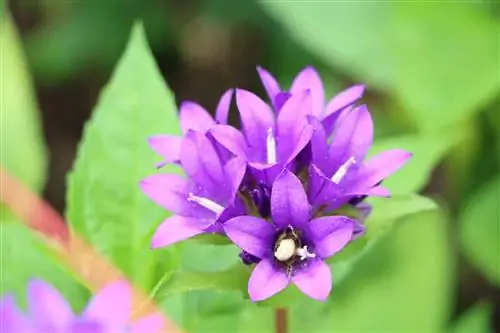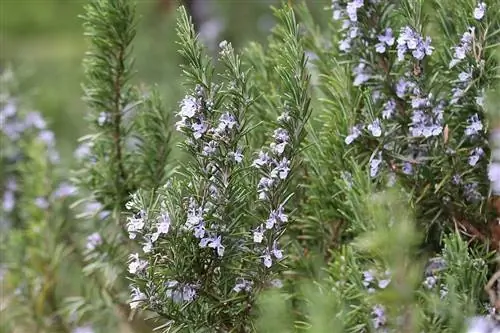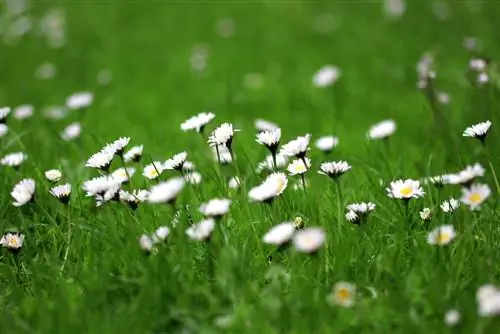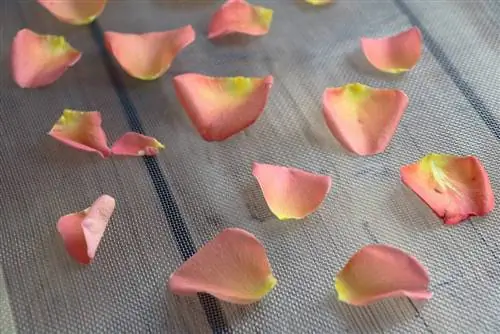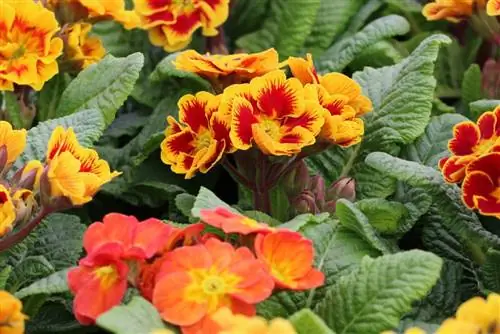- Author admin [email protected].
- Public 2023-12-17 03:39.
- Last modified 2025-01-24 12:45.
More and more hobby gardeners are making their gardens bee-friendly in order to provide the little ones with rich sources of food. It doesn't require a lot of resources. Below we give you some tips for planting.
Asters (Aster)
Growth height: 5 cm to 300 cm
Growth width: 20 to 90 cm
Bloom
- Flower basket consisting of long ray and ray flowers
- small, yellow tubular flowers in the middle
- ray flowers protruding horizontally from tubular flowers
- usually form a single-row wreath, sometimes also a multi-row wreath
- Diameter flower basket 2 to 5 cm
- Flowers terminally on slightly hairy stems
- occurring singly or in groups
- Color white, purple, red, pink and shades of blue
Growth
- herbaceous growing
- upright either branched or unbranched stems
- creeping rhizomes
- green ovate to lanceolate leaves
- variant on the stem
- A rosette of leaves often forms on the ground
- Leaves either stalked or sessile
- smooth or hairy
- serrated or smooth leaf edge
- brown-gray leaf color in autumn
Flowering time: May to November
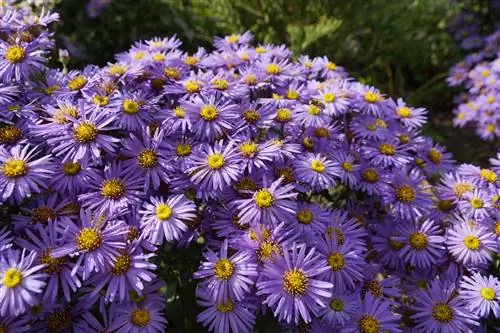
Location: sunny to partially shaded
Floor
- fresh
- permeable
- rich in nutrients and humus
- normal garden soil is sufficient
Blue catnip (Nepeta x faassenii)
Growth height: 30 to 60 cm
Growth width: 20 to 30 cm
Bloom
- Flower color violet to blue
- lip-shaped, small flowers in spikes
- strongly scented
Growth
- loose and bushy
- Horste forming
- grey-green, fragrant, oval-heart-shaped leaves
- leaf edge serrated
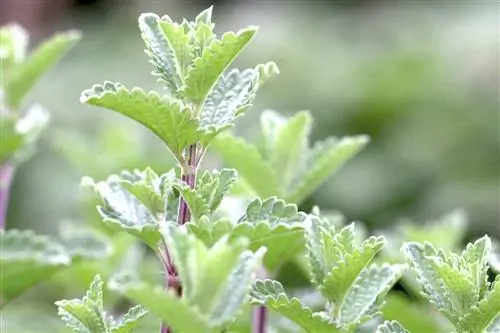
Flowering time: May to September
Location: sunny
Floor
- pH value neutral to slightly acidic
- dry to fresh
- sandy to loamy
- permeable, moderately nutrient-rich, mineral
Tip:
Catnip is the perfect companion for roses.
Lady's Mantle (Alchemilla)
Growth height: 10 to 60 cm
Growth width: 30 to 50 cm
Bloom
- yellow-green, small individual flowers
- standing together in clumps on hairy shoots
Growth
- growing lushly
- woody rhizomes
- round to kidney-shaped, yellowish-green leaves
- palately divided, cleft or lobed
- partly hairy
- serrated or sawn leaf edge
Flowering time
- June to July
- sometimes until October
Location: sunny to partially shaded
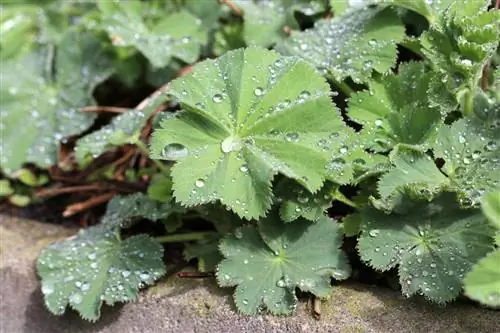
Floor
- nutrient-rich
- permeable
- fresh to moderately moist
- problems even on drier soils
- loamy to sandy
Tip:
Pruning close to the ground immediately after flowering stimulates new growth.
Common Yarrow (Achillea millefolium)
Growth height: 20 to 80 cm
Growth width: 40 to 50 cm
Flower: white, fragrant false umbel
Growth
- prostrate to tightly upright
- forms runners
- soft, pinnate leaves
- fragrant and dark green
Flowering time: July to September
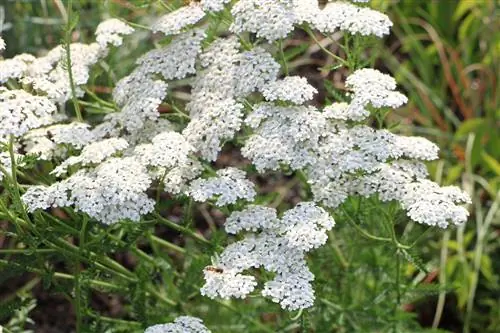
Location: sunny
Floor
- fresh to moist
- permeable
- humus-rich
- neutral to sour
Tip:
In order to prevent the plant from aging, it should be divided after four to five years.
Goldenrod (Solidago)
Growth height: 50 to 120 cm
Growth width: 55 to 60 cm
Bloom
- golden yellow flower heads
- standing together in panicles
- Parine branches slightly curved
Growth
- compact and upright
- leafed stems
- forms Horste
- smooth, deep green, lanceolate leaves
- full to sawn leaf edge
- tapering at the end
- Leaves alternate
Flowering time: July to September
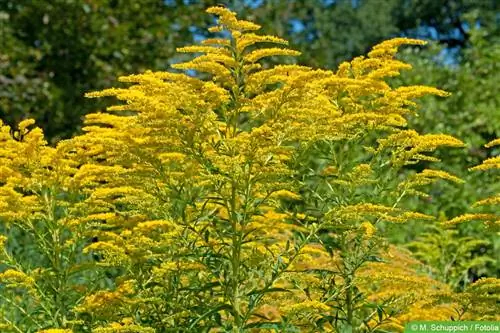
Location: sunny
Floor
- permeable and fresh
- humus-rich
- sandy to loamy
Note:
The goldenrod tends to self-sow, so pruning should be done immediately after flowering. The flowers also have a honey-like taste and are ideal for making syrup.
Astrantia major
Growth height: 50 to 70 cm
Growth width: 40 to 50 cm
Bloom
- simple, terminal umbel flower
- Colors Green, Red, White
- greenish bracts
Growth
- bushy
- upright flower stalks
- forms Horste
- glossy green, palmately lobed leaves
- sawn leaf edge
Flowering time: June to August
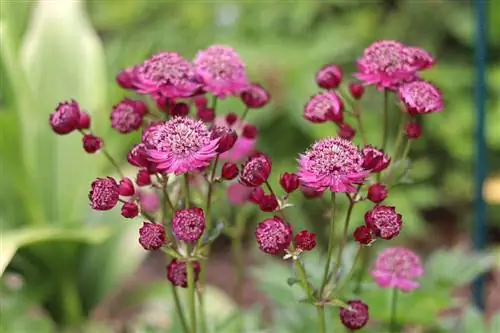
Location: shaded to partially shaded
Floor
- fresh to moderately moist
- humus and nutrient-rich
- permeable
- loamy to sandy
- pH value neutral
- Plant loves lime
Indian nettle (Monarda didyma)
Growth height: 80 to 150 cm
Growth width: 50 to 70 cm
Bloom
- Flower color dark to light red
- ball-shaped
- reddish bracts
- pleasant scent
Growth
- bushy, upright growing
- forms runners
- lanceolate, pointed leaves
- Underside softly hairy
- Leaf edge sawn
- deep green and fragrant
- square stems
Flowering time: June to August
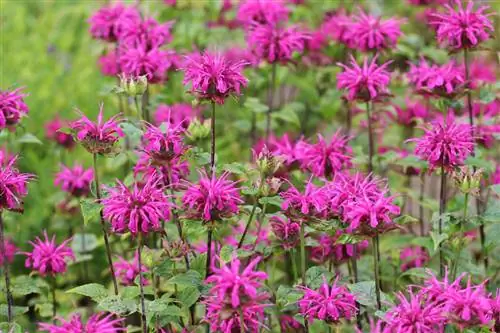
Location: sunny to slightly partially shaded
Floor
- permeable garden soil
- fresh and nutritious
- neutral area
Tip:
The Indian nettle is also suitable for keeping in containers. The leaves and flowers are edible. They are used to make tea and spices and in medicine.
Jacob's Ladder (Polemonium caeruleum)
Growth height: 60 to 70 cm
Growth width: 40 to 50 cm
Bloom
- small, cup-shaped, blue flowers
- standing together in dense flower spikes
- long yellow to orange stamens
Growth
- upright
- Horste forming
- alternate, green, soft leaves
- pinnate-elongated and entire
Flowering time: June to July
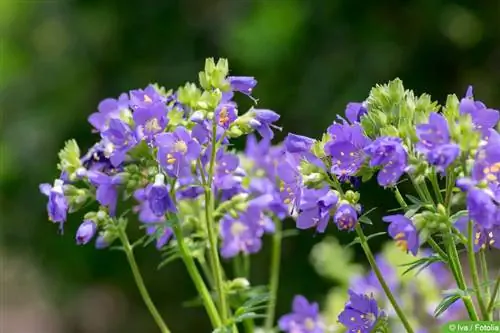
Location
- prefers partial shade
- sunny also possible
Floor
- fresh to moist
- permeable
- humus and nutrient-rich
- sandy to loamy
- slightly acidic to slightly alkaline
Ballbellflower (Campanula glomerata)
Growth height: 50 to 60 cm
Growth width: 25 to 30 cm
Bloom
- terminal, small bell-shaped flowers
- standing together in clumps
- Color blue to dark purple
- there is also a white cultivated form
Growth
- upright stems
- basal tuft of leaves
- Forming runners
- lanceolate, rough, green-red leaves
- fine hairy
- Leaf edge slightly serrated
Flowering time: June to August
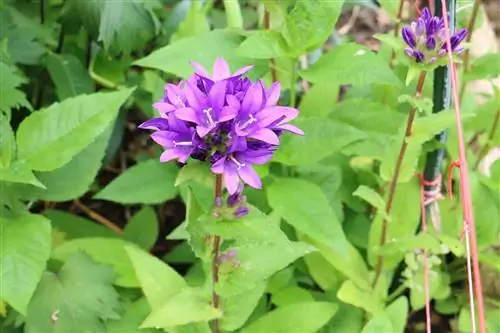
Location: sunny to partially shaded
Floor
- fresh to moderately moist
- permeable
- humus and nutrient-rich
- loamy to gravelly
- pH alkaline
- Plant loves lime
Cockade flower (Gaillardia x grandiflora)
Growth height: 10 to 75 cm
Growth width: 20 to 30 cm
Bloom
- terminal single flower
- radial shape
- hemispherical, brown flower center
- Flower color red with yellow border
Growth
- compact, dense and bushy
- upright flower stalks
- lanceolate leaves rounded at the tip
- colored dark green and finely haired
- full margin
Flowering time: July to October
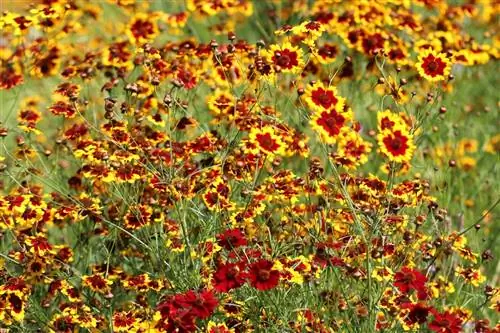
Location: sunny
Floor
- fresh to moderately dry
- permeable
- rich in nutrients and humus
- gravelly to sandy
- slightly acidic to slightly alkaline
- Plant tolerates lime
Tip:
In severe frosts, the root area should be covered with fleece, leaves or brushwood
Globe thistle (Echinops ritro)
Growth height: 60 to 100 cm
Growth width: 60 to 80 cm
Bloom
- spherical buds with a diameter of 2 to 4 cm
- ball-shaped, light to violet-blue flowers
- Development of a beautiful seed head after flowering
Growth
- loose, upright
- Horste forming
- basal tuft of leaves
- matte, grey-green, coarse leaves
- feathered
- Leaf edge booked
Flowering time: July to September
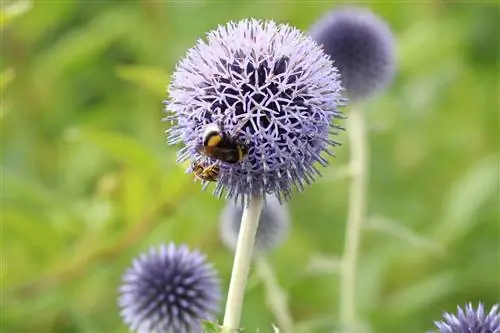
Location: sunny
Floor
- dry to moderately moist
- permeable
- moderately rich in nutrients and humus
- gravelly to loamy
- pH value neutral
- Plant tolerates lime
Note:
The globe thistle tends to self-sow. Pruning in autumn is advisable.
Girl's Eye (Coreopsis)
Height: 10 to 180 cm
Growth width: 30 to 50 cm
Bloom
- numerous, radiating flowers
- yellow with dark center
- there are also colored cultivated forms
Growth
- compact, upright and bushy
- Horste forming
- pinnate, smooth, narrow, green leaves
- full margin
Flowering time: June to October
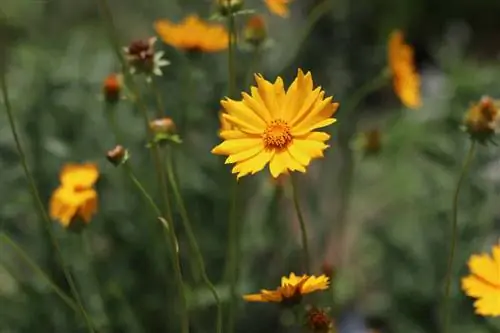
Location: sunny
Floor
- loose soil
- humus and nutrient-rich
- permeable
Tip:
Pruning in late autumn ensures a lush bloom the following year
Musk mallow (Malva moschata)
Growth height: 50 to 60 cm
Growth width: 55 to 60 cm
Bloom
- soft pink
- cup-shaped
- pleasantly scented
Growth
- bushy, upright
- Horste forming
- filigree stems
- fine, narrow, green leaves
Flowering time: June to September
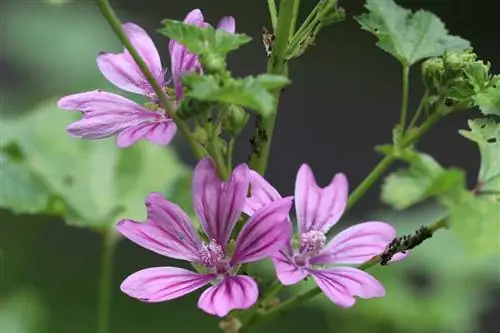
Location: full sun
Floor
- dry to fresh
- permeable
- humus and nutrient-rich
- loamy to sandy
Note:
The musk mallow is a well-known medicinal plant for respiratory and urinary tract infections. The flowers are edible.
Splendid Stonecrop (Sedum spectabile)
Growth height: 40 to 50 cm
Growth width: 40 to 50 cm
Bloom
- star-shaped, small flowers
- arranged in umbels
- Umbels larger than 10 cm
- Flower color dark red to purple
Growth
- bushy with upright flower stalks
- Horste forming
- rough, succulent, oval leaf
- Leaf edge booked
Flowering time: August to September/October
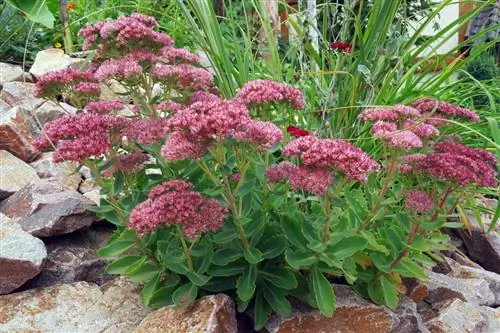
Location: full sun
Floor
- dry to fresh
- permeable
- normal garden soil
Note:
After flowering, a beautiful fruit cluster forms. This stays on the bed for a long time.
Purple Coneflower (Echinacea purpurea)
Growth height: 80 to 100 cm
Growth width: 40 to 50 cm
Bloom
- ray-shaped flower heads
- purple pink and slightly scented
- high arched, brown-red flower center
- Flower head larger than 10 cm
- Initially ray flowers standing horizontally
- later hanging slightly downwards
Growth
- upright and bushy
- Horste forming
- leafed stems
- rough, rough, dark green, lanceolate leaves
- full margin
Flowering time: July to September
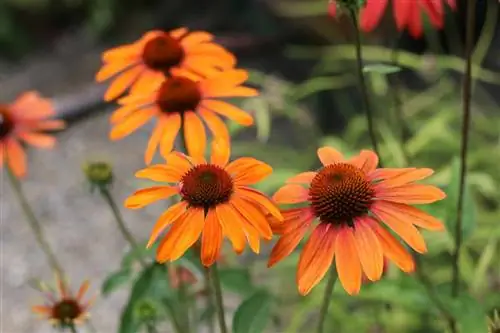
Location: sunny to slightly partially shaded
Floor
- permeable
- fresh to moderately dry
- rich in nutrients and humus
- sandy to loamy
- slightly acidic to alkaline
- Plant tolerates lime
Note:
The coneflower is a proven medicinal plant.
Delphinium (Delphinium)
Height: 150 to 180 cm
Growth width: 70 to 80 cm
Bloom
- small, semi-double flowers with white eye
- standing together in panicles
- backwards spur on the back of the flower
- Colors light to dark blue, white, violet
Growth
- upright
- Horste forming
- Flower stems with leaves
- dull green, deeply cut, palmate leaves
- lobed leaf edge
Flowering time: June to September
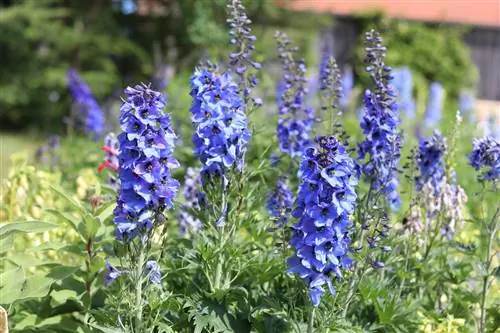
Location: sunny with low underplanting
Floor
- fresh to slightly moist
- permeable
- humus and nutrient-rich
- loamy
Note:
Poisonous alkaloids are contained in all parts of the plant, mainly the seeds. To obtain a second flower, it is necessary to cut back a hand's breadth above the ground after the main flower.
Sun Bride (Helenium)
Height: 60 to 160 cm
Growth width: up to 80 cm
Bloom
- one or more flower heads per stem
- spherical to hemispherical shaped
- small, brown flowers in the middle
- wheel-shaped arrangement of ray flowers around it
- Petals grown together to form a tube
- Color from yellow to orange to copper red
Growth
- upright, bushy
- Horste forming
- upright stems
- alternate, dark green leaves
- Shape oval to lanceolate or pinnately cut
- leaf edge serrated
Flowering time: June to October
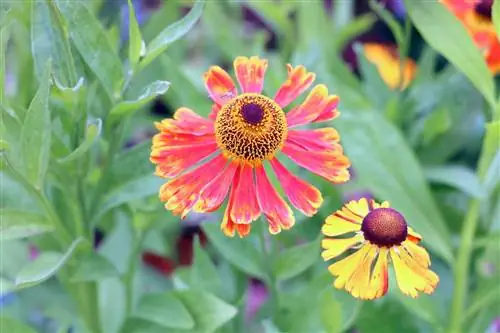
Location
- sunny and sheltered from the wind
- the sunnier, the brighter the flowers are
- light partial shade for plants with dark flowers
Floor
- fresh to moist
- rich in nutrients and humus
- loamy preferred
- slightly acidic to slightly alkaline
- Plant tolerates lime
Tip:
To strengthen growth, radical pruning should be carried out in the first year immediately after flowering.

